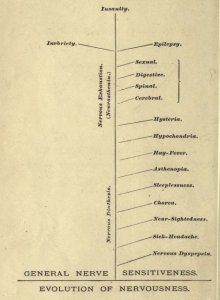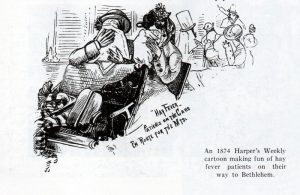A New Disease
The post-Civil War era in America became the heyday of medical discovery using innovations from the war itself such as proper hygiene, rest, and diet. The war also brought new ideas concerning mental diseases and disorders. With the economic prosperity of Gilded Age America beginning to take off, upper-class Americans started to experience stress having to do with their elite professions, the city, and the weight of having an educated mind. As their stress rose symptoms of a new mental disorder began to take affect. the term for this disorder, nervous exhaustion, was first coined by Edwin H.Van Deusen, an

alienist who, after treating asylum patients, realized the effect stress had on manifesting several mental disorders.[1] Yet Van Deusen, due to his non-medical profession, was unable to gain the disorder’s acceptance as a widespread medical phenomena until neurologists George M. Beard and S. Weir Mitchell popularized nervous exhaustion by explaining it as a disease of elite America. Nervous exhaustion would leave its mark on the late 19th century not only as a misguided medical diagnosis and a re-enforcer of social Darwinism; it also left a mark on the White Mountains and its tourist industry.
Hay-Fever: A Symptom of Civilization
Now how did Americans’ weak nervous system bring the elite to the White Mountains? The answer: Hay-fever.[2] For years the White Mountains had been a sanctuary to those who suffered from the seasonal affliction, but nervous exhaustion (or neurasthenia) would soon transform Bethlehem,NH into the vacation spot of elite America. The connection between hay-fever and nervous exhaustion was popularized by Beard himself. In his Treatise on Nervous Exhaustion, Beard’s list of symptoms include phobias, hysteria, lack of sleep, and of course hay-fever. This common symptom of elites in the city whose weak nerves were further irritated by pollution could be treated by several methods. Beard’s favorite method was electricity, as he believed the stimulation would re-energize nerves; other treatments included arsenic, and opium. S. Weir Mitchell would also formulate the rest cure to help with neurasthenia and relax the over- worked nerves of upper-class Americans.[3] Yet the best and perhaps the most popular treatment according to Beard was travel.[4]

Yet it could not be rugged travel as that would only weaken nerves further, so the deserts of Arizona and old sea coast towns could not accommodate ill upper-class Americans.[5] Bethlehem, NH, with its luxury hotels, leisure activities, and obliging locals who capitalized on the tourist industry, made it the vacation home for the rich and well- to- do to relax and gain strength and health. Even Bethlehem travel guides and information booklets began to preach the gospel of nervous exhaustion[6]. The upper class had an open invitation at Bethlehem to recuperate from their stress.
Nervous Exhaustion and the Clash of Class

Nervous exhaustion was a stepping stone towards diagnosing mental disorders and recognizing stress as a cause of certain mental afflictions. It was, however, a disease of its time. The doctors who diagnosed and treated nervous exhaustion only associated it with the elite upper-middle class, as they were the educated members of society. Those who were a part of the working class could never be diagnosed with nervous exhaustion as they had no reason to use their brains in complicated ways. Nervous exhaustion was not merely a popular disease of 19th century America. It was a social and economic standard for post-Civil War America.
GeorgiaAnne Brown, Senior
Works Cited:
[1]: Schuster, David G. Neurasthenic Nation: America’s Search for Health, Happiness, and Comfort, 1869-1920. Brunswick, N.J.: Rutgers University Press, 2011.
[2]:Schuster, David G. Neurasthenic Nation: America’s Search for Health, Happiness, and Comfort, 1869-1920. Brunswick, N.J.: Rutgers University Press, 2011.
[3]:Schuster, David G. Neurasthenic Nation: America’s Search for Health, Happiness, and Comfort, 1869-1920. Brunswick, N.J.: Rutgers University Press, 2011.
[4]: Beard, George M. A Practical Treatise on Nervous Exhaustion (Neurasthenia): Its Symptoms, Nature, Sequences, Treatment. New York: E.B. Treat, 1905.
[5]: Mitman, Gregg. “Hay Fever Holiday: Health, Leisure, and Place in Gilded Age America” Bulletin of the History of Medicine 77, no 3 (2003): 600-635.
[6]:“The White-Mountain Village of Bethlehem as a Resort for Health and Pleasure”. Boston: Rand, Avery, & Co. 1880
